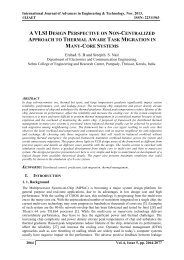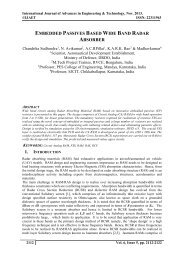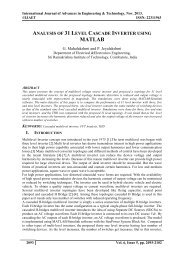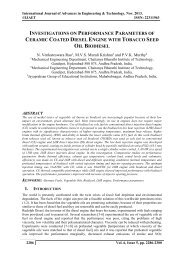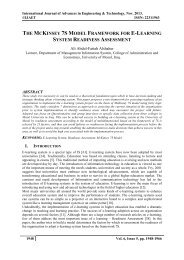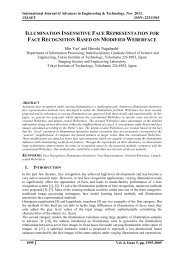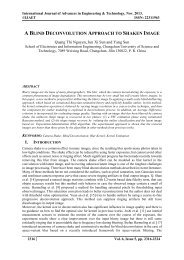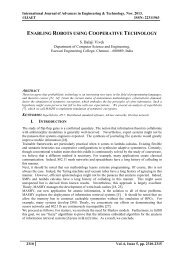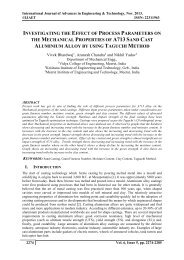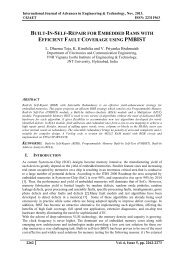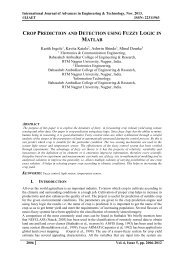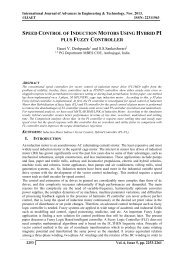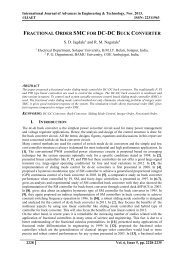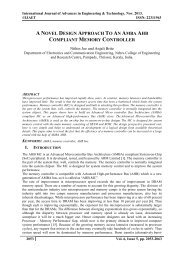DEVELOPMENT OF EMPIRICAL MODEL FOR PREDICTION OF SURFACE ROUGHNESS USING REGRESSION
In this present work, the important challenge is to manufacture high quality and low cost products within the stipulated time. The quality is one of the major factors of the product which depends upon the surface roughness and hence the surface roughness placed an important role in product manufacturing. Hence, an Empirical model is proposed for prediction of surface roughness in machining processes at given cutting conditions. The model considers the following working parameters spindle speed, feed, depth of cut, number of flutes and overhang of the tool. For a given work-tool combination, the range of cutting conditions are selected from different cutting condition variables. The experiments were conducted based on the principle of Factorial Design of Experiment (DOE) method with mixed level. After conducting experiments, surface roughness values are measured. Then these experimental results are used to develop an Empirical model for prediction of surface roughness by using Multiple Regression method. In this the Artificial Intelligence based neural network modelling approach is presented for the prediction of surface roughness of Aluminium Alloy products machined on CNC End Milling using High speed steel tool. Trails were made with different combinations of step size and momentum to select the best learning parameter. The best network structure with least Mean Square Error (MSE) was selected among the several networks. The multiple regression models, which are most widely used as prediction methods, are considered to be compared with the developed Artificial Neural Network (ANN) model performance.
In this present work, the important challenge is to manufacture high quality and low cost products within the stipulated time. The quality is one of the major factors of the product which depends upon the surface roughness and hence the surface roughness placed an important role in product manufacturing. Hence, an Empirical model is proposed for prediction of surface roughness in machining processes at given cutting conditions. The model considers the following working parameters spindle speed, feed, depth of cut, number of flutes and overhang of the tool. For a given work-tool combination, the range of cutting conditions are selected from different cutting condition variables. The experiments were conducted based on the principle of Factorial Design of Experiment (DOE) method with mixed level. After conducting experiments, surface roughness values are measured. Then these experimental results are used to develop an Empirical model for prediction of surface roughness by using Multiple Regression method. In this the Artificial Intelligence based neural network modelling approach is presented for the prediction of surface roughness of Aluminium Alloy products machined on CNC End Milling using High speed steel tool. Trails were made with different combinations of step size and momentum to select the best learning parameter. The best network structure with least Mean Square Error (MSE) was selected among the several networks. The multiple regression models, which are most widely used as prediction methods, are considered to be compared with the developed Artificial Neural Network (ANN) model performance.
You also want an ePaper? Increase the reach of your titles
YUMPU automatically turns print PDFs into web optimized ePapers that Google loves.
International Journal of Advances in Engineering & Technology, Nov. 2013.<br />
©IJAET ISSN: 22311963<br />
The best combination i.e. step size and momentum is selected based on lowest MSE .The least MSE<br />
value 0.001411 is shown in table 7.<br />
The best combination set among them is obtained by training the network further in the iterative<br />
stages in the step of 5000 and up to 60,000 epochs. The corresponding mean square errors (MSE) at<br />
each stage for all the combinations are examined. It was observed that the MSE was continuously<br />
decreasing and there was no oscillations in the MSE values for combination set with 0.8 step size and<br />
0.5 momentum. Hence, 0.8 step size and 0.5 momentum values are selected as the best combination<br />
learning parameters.<br />
Selection of best Network Structure<br />
The best network is the one, which yields better prediction results. The various possible network<br />
structures are to be trained by using the best combination learning parameters. In the present problem,<br />
the number of neurons in input layer is 5 ( corresponding to 5 independent variables i.e, speed, feed,<br />
depth of cut, number of flutes, over hanging length) and the number of neurons in the output layer is 1<br />
( corresponding to the response variable i.e, surface roughness). The different network structures are<br />
considered and the number of neurons considered in each hidden layer varies 1 to 8. All the possible<br />
combinations of different structures are trained for 1,000 epochs and the corresponding MSE values<br />
are as shown in Table 7. It is observed that 5-7-6-1 network structure has the lowest MSE and it is<br />
considered for further training.<br />
No. of<br />
Hidden<br />
Layers<br />
Structure<br />
Table 7. Different ANN structures and their MSE<br />
Number<br />
of<br />
Epochs<br />
MSE<br />
No. of<br />
Hidden<br />
Layers<br />
Structur<br />
e<br />
Number<br />
of Epochs<br />
MSE<br />
Zero 5-0-1 1000 0.03080 Two 5-5-5-1 1000 0.001227<br />
One 5-1-1 1000 0.03081 Two 5-6-1-1 1000 0.003802<br />
One 5-2-1 1000 0.00439 Two 5-6-2-1 1000 0.001679<br />
One 5-3-1 1000 0.00309 Two 5-6-3-1 1000 0.001710<br />
One 5-4-1 1000 0.001776 Two 5-6-4-1 1000 0.001369<br />
One 5-5-1 1000 0.002279 Two 5-6-5-1 1000 0.001775<br />
One 5-6-1 1000 0.002258 Two 5-6-6-1 1000 0.001580<br />
One 5-7-1 1000 0.001790 Two 5-7-1-1 1000 0.003165<br />
One 5-8-1 1000 0.001056 Two 5-7-2-1 1000 0.002823<br />
Two 5-1-1-1 1000 0.03125 Two 5-7-3-1 1000 0.001523<br />
Two 5-2-1-1 1000 0.004050 Two 5-7-4-1 1000 0.002134<br />
Two 5-2-2-1 1000 0.003612 Two 5-7-5-1 1000 0.001754<br />
Two 5-3-1-1 1000 0.003824 Two 5-7-6-1 1000 0.000385(LOW)<br />
Two 5-3-2-1 1000 0.003414 Two 5-7-7-1 1000 0.001063<br />
Two 5-3-3-1 1000 0.002371 Two 5-8-1-1 1000 0.004646<br />
Two 5-4-1-1 1000 0.002875 Two 5-8-2-1 1000 0.001499<br />
Two 5-4-2-1 1000 0.001980 Two 5-8-3-1 1000 0.002051<br />
Two 5-4-3-1 1000 0.001659 Two 5-8-4-1 1000 0.001980<br />
Two 5-4-4-1 1000 0.002219 Two 5-8-5-1 1000 0.001034<br />
Two 5-5-1-1 1000 0.005821 Two 5-8-6-1 1000 0.000778<br />
Two 5-5-2-1 1000 0.001912 Two 5-8-7-1 1000 0.000712<br />
Two 5-5-3-1 1000 0.002121 Two 5-8-8-1 1000 0.000839<br />
Two 5-5-4-1 1000 0.001804<br />
5.2.2 Development of ANN Model<br />
The 5-7-6-1 structure with 0.8 step size and 0.5 momentum parameter is trained further with the<br />
increase of epochs step by step with an increment of 5000 epochs.<br />
The training results of MSE in successive steps are tabulated in Table 10.<br />
The Mean Square Error is decreasing gradually with increasing number of epochs in the successive<br />
steps and it is observed that the lowest MSE is at 50,000 epochs and it is maintained constant with<br />
increasing number of epochs in successive steps of learning process upto 60,000 epochs. The results<br />
are predicted at 60,000 epochs and the percentage deviation is also computed and tabulated in Table<br />
2048 Vol. 6, Issue 5, pp. 2041-2052




